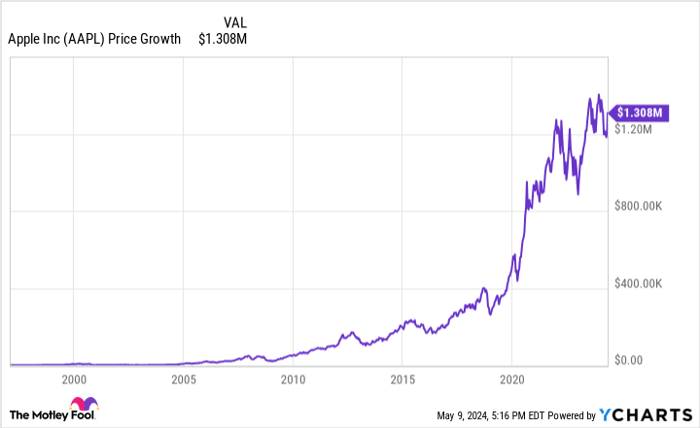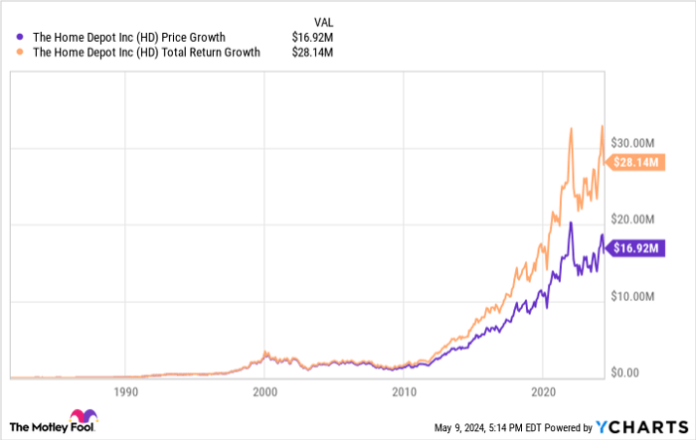Most growth investors dream of finding a small-cap stock that yields returns of 1,000-fold or more as it goes from obscurity to international leader in its field.
These stocks are difficult to identify early. Worse, even when you see such an opportunity, factors such as poor management or unexpected changes in a market can derail a potential success.
Still, the histories of Home Depot (NYSE: HD) and Apple (NASDAQ: AAPL) can offer lessons in identifying new market niches early, helping investors visualize the potential for massive growth at an early stage.
1. Home Depot
Home Depot successfully brought the concept of the superstore for home improvement to the masses across the U.S., Canada, and Mexico. Founders Bernie Marcus and Arthur Blank built their company on a “customer bill of rights,” offering visitors the best selections, quantities, and prices with trained sales associates to help them find what they need.
It launched its initial public offering (IPO) in 1981, just two years after opening its first two Atlanta-area locations, and its stock has been one of the most successful in history. A $1,000 purchase of the retail stock on the IPO day is now worth almost $17 million.
Also, that does not include dividend income, which would have produced an additional $11 million between its introduction in 1987 and today. That takes the total return to more than $28 million.

HD data by YCharts
The payout, which is now about $11 per share yearly, has grown from less than $0.002 per share annually in 1987 — an increase of more than 5,100-fold.
Ultimately, the early launch of its stock and dividend, rapid expansion across the U.S., and later expansions into Canada and Mexico drove massive returns for investors.
Admittedly, Home Depot has so far not succeeded in expanding beyond North America, and growth has slowed as it has saturated its core markets. Although that arguably makes it a better stock for storing than growing wealth today, studying Home Depot’s history may help investors identify potential opportunities in today’s retail market.
2. Apple
Apple launched its IPO in 1980. However, Steve Jobs’ first stint with the company he founded ended in his firing. The company and stock languished without Jobs, and by the time Apple bought out another Steve Jobs company, NeXT, Inc., in 1997, Apple was close to bankruptcy.
Thus, growth investors will likely want to focus on Jobs’ second CEO tenure. If you bought $1,000 in Apple stock when Steve Jobs returned as CEO in February 1997, you would have $1.3 million in the consumer-oriented tech stock today.

AAPL data by YCharts
This growth occurred because Jobs revolutionized the company, adding new products such as the iPod. He also revitalized the Mac ecosystem, striking a deal with Microsoft to develop a Mac version of Office so Mac users could work with users outside of its ecosystem.
Still, its most game-changing product was the launch of the iPhone in 2007. This began the smartphone industry, revolutionizing communication and forcing cellular phone producers such as Nokia out of the market. It also reduced the need for PCs, which brought years of uncertainty for Apple’s longtime rival Microsoft.
Consequently, the iPhone eventually emerged as Apple’s primary revenue driver. It served as the focal point of Apple’s iOS ecosystem, which connects to its Mac computers and the large selection of tech-related services offered by the company. Such innovations have made it the second-largest company by market cap trading on U.S. exchanges today, showing how the right innovation and management leadership can bring massive gains.
The path from $1,000 to $1 million
Home Depot and Apple offer lessons for a stock’s growth potential, but hindsight may make this process deceptively easy.
Home Depot was largely unknown in the beginning, and Apple looked like it was on the brink of bankruptcy. Thus, investors would have had to buy when the risk of failure was high to earn such returns. Also, investors typically have to bet on unknown managers, a risky proposition when poor management can undermine even the best business ideas.
However, rather than beating yourself up for not buying at such times, look at industry innovations and their potential for transformative success. Such epiphanies may come too late to turn $1,000 into $1 million, but recognizing such potential early could still turn small investments into sizable positions.
Should you invest $1,000 in Home Depot right now?
Before you buy stock in Home Depot, consider this:
The Motley Fool Stock Advisor analyst team just identified what they believe are the 10 best stocks for investors to buy now… and Home Depot wasn’t one of them. The 10 stocks that made the cut could produce monster returns in the coming years.
Consider when Nvidia made this list on April 15, 2005… if you invested $1,000 at the time of our recommendation, you’d have $550,688!*
Stock Advisor provides investors with an easy-to-follow blueprint for success, including guidance on building a portfolio, regular updates from analysts, and two new stock picks each month. The Stock Advisor service has more than quadrupled the return of S&P 500 since 2002*.
See the 10 stocks »
*Stock Advisor returns as of May 6, 2024
Will Healy has no position in any of the stocks mentioned. The Motley Fool has positions in and recommends Apple, Home Depot, and Microsoft. The Motley Fool recommends the following options: long January 2026 $395 calls on Microsoft and short January 2026 $405 calls on Microsoft. The Motley Fool has a disclosure policy.
The views and opinions expressed herein are the views and opinions of the author and do not necessarily reflect those of Nasdaq, Inc.

